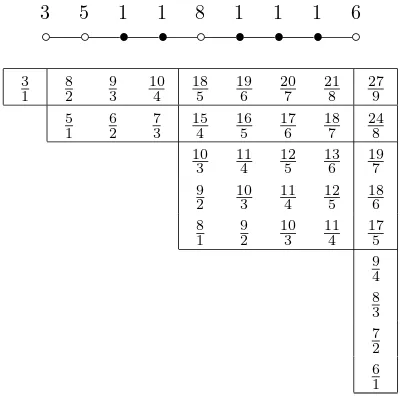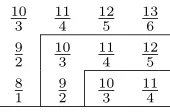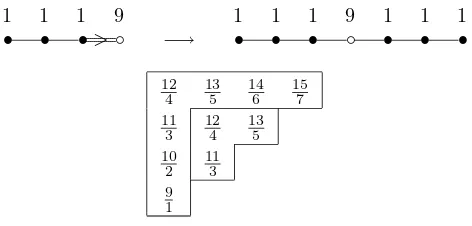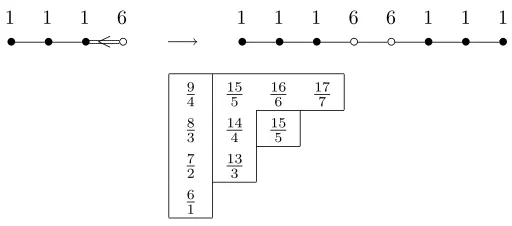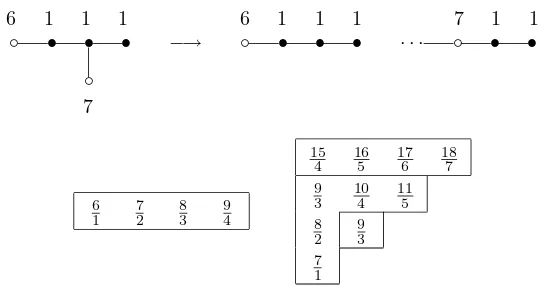Bounds for the Anticanonical Bundle of a
Homogeneous Projective Rational Manifold
Dennis Snow
Received: February 26, 2004
Communicated by Thomas Peternell
Abstract. The following bounds for the anticanonical bundleK∗ X =
detTX of a complex homogeneous projective rational manifoldX of dimensionnare established:
3n≤dimH0(X, KX∗)≤
µ2n+ 1
n
¶
and 2nn!≤degKX∗ ≤(n+ 1)n
with equality in the lower bounds if and only ifX is a flag manifold and equality in the upper bounds if and only ifX is complex projective space. None of these bounds holds for general Fano manifolds.
2000 Mathematics Subject Classification: Primary 14M17; Secondary 14M15, 32M10
The homogeneous compact complex manifolds X that admit an equivariant embedding in projective space are precisely the quotientsX =G/P where G
is a semisimple complex Lie group and P is a parabolic subgroup. Moreover, any such quotient is rational and has a very ample anticanonical bundle,K∗
X =
detTX. In particular,X is a Fano manifold.
Various bounds have been established for the numerical invariants ofK∗ Xwhen X is a general Fano manifold, see [6, 8, 9, 10]. For example, there exists a constant c(n) that depends only onn= dimX such that degK∗
X ≤c(n)n. In
this article we establish the following bounds whenX =G/P:
3n≤dimH0(X, KX∗)≤
µ 2n+ 1
n
¶
and 2nn!≤degKX∗ ≤(n+ 1)n
These bounds do not hold for general Fano manifolds. For example, let X =
P(OPn−1⊕ OPn−1(n−1)). ThenX is aP
1-bundle overPn−1,π:X →Pn−1,
andK∗
X =π∗OPn−1(1)⊗ξ
2whereξis the tautological line bundle onX whose
restriction to any fiber P1 of π gives ξ|P1 ∼= OP1(1). It follows that X is
a Fano manifold with dimH0(X, K∗
X) = n+
¡2n−1 n−1
¢
+¡3n−2 n−1
¢
and degK∗ X =
((2n−1)n−1)/(n−1). An example where the lower bounds do not hold is
given byX =S×(P1)n−2whereS is a del Pezzo surface.
In the homogeneous case there are well-known formulas from representation theory that can be used to calculate dimH0(X, K∗
X) and degKX∗ exactly.
How-ever, these formulas, which are products of rational numbers indexed by the roots of the group, do not easily lend themselves to comparison with expres-sions in n = dimX. The point of this paper is to overcome this difficulty. The bounds are proved by first reducing to the case of simple Lie groups and then showing for each classical type that the known formulas can be broken up into subproducts of certain simple sequences. These subproducts are shown to satisfy inequalities that can be combined to yield the desired inequalities for the full product. The bounds for the exceptional types are verified through exhaustive calculations.
The above upper bounds can be trivially extended to any homogeneous compact complex manifold X =G/H. The sections ofK∗
X define an equivariant map
of X to projective space that coincides with the normalizer fibrationG/H→
G/N, N = NG(H0), [1, p.79]. Since the base Y = G/N is a homogeneous
projective rational manifold, the upper bounds hold forY and hence forX. For a homogeneous projective rational manifoldX, the dimension of the holo-morphic automorphism group, dim Aut(X) = dimH0(X, TX), never exceeds n(n+2). In fact, this bound holds whenXis any homogeneous compact K¨ahler manifold [5]. However, there are homogeneous compact complex manifolds for which dim Aut(X) grows exponentially inn, see [12]. In [13], the above estimate for dimH0(X, K∗
X) plays an important role in establishing the following bound
for the non-K¨ahler case: dim Aut(X)≤n2−1+¡2n−1 n−1
¢
∼O(22n−1/p
(n−1)π).
1 Roots and Weights
In this section we introduce some notation and well-known facts about semisim-ple Lie groups [2, 7], and recall a formula for finding the weightµX associated to the line bundleK∗
X whenX =G/P [4, 11].
LetGbe a semisimple complex Lie group and letT be a maximal torus of G. Let Lie(G) and Lie(T) be the corresponding Lie algebras. Let Φ ⊂ Lie(T)∗
denote the roots of G with respect to T and let {α1, . . . , αℓ} be a system of simple roots. Let Φ+ denote the subset of positive roots—those that are
positive integral combinations of the simple roots. For any root α ∈ Φ, let
eα ∈ Lie(G) be the corresponding root vector: [x, eα] = α(x)eα for all x ∈ Lie(T).
Any weightµ∈Lie(T)∗ can be writtenµ=Pℓ
i=1hµ, αiiλi.
A Borel subgroup is a maximal solvable subgroup ofG, and any such subgroup is conjugate to the subgroup B generated byT and the root groups expCeα,
for all α ∈ −Φ+. Let P be a parabolic subgroup ofG, that is, a subgroup
containing a Borel subgroup. We may assume thatPcontainsB. LetP =R·S
be a Levi decomposition ofP whereRis a maximal solvable normal subgroup ofP andSis semisimple. We let ΦP denote the subsystem of roots ofSand let
Φ+P = ΦP∩Φ+. LetI denote the subset of indexes, I⊂ {1, . . . , ℓ}, such that
Φ+P∩ {α1, . . . , αℓ}={αi}i∈I. The conjugacy class ofP is uniquely determined
byI and any such choice of indexes is associated to a parabolic subgroup ofG. Let X = G/P, and define Φ+X = Φ+\ Φ+
P. Since TX is generated at the
identity coset by the root vectors eα for α ∈ Φ+X, the anticanonical bundle K∗
X = detTX, n = dimX, is the homogeneous line bundle associated to the
weight
µX = X
α∈Φ+ X
α
The weightµX is dominant: hµX, αii>0 fori /∈I, andhµX, αii= 0 fori∈I. In particular, K∗
X is a very ample line bundle and µX is orthogonal to the
roots Φ+P. IfP=B,X is called a flag manifold.
We now recall a simple formula for calculating the coefficientshµX, αiiofµX, see [11]: A set of indexesJ is called connected if the subdiagram of the Dynkin diagram of G corresponding to the simple rootsαj, j ∈J, is connected. An index iis said to be adjacent toJ ifi6∈J andJ0∪ {i} is connected for some connected component J0 ofJ. The set of indexes adjacent toJ is denoted by
∂J. The number of elements inJ is denoted|J|.
Definition 1 LetJ be a connected set of indexes. Fori6∈∂J defineνi(J) = 0. Fori∈∂Jdefineνi(J)to be the number next to the appropriate diagram below. The black nodes correspond toJand the white node corresponds toi. Symmetry of Dynkin diagrams is tacitly assumed.
◦ • · · · • • |J|,
◦ • · · · •>• 2|J| −1, • • · · · •>◦ 2|J|,
◦ • · · · •<• 2|J|, • • · · · •<◦ |J|,
◦ • · · · • • •
• 2|J| −2, • • · · · • • •
◦ 2|J| −2,
◦ • • •
• • 10, • • •
◦
• • 9,
◦ • • • •
• • 16, • • • •
•
• ◦ 15,
• • • • ◦
• • 12, ◦ • • • •
•
• • 27,
• • • • • •
• ◦ 21, • • • • • ◦
• • 15,
◦ •>• • 6, • •>• ◦ 9,
For an arbitrary set of indexes I define νi(I) = νi(I1) +· · ·+νi(Ip) where I1, . . . , Ip are the connected components ofI.
Proposition 1 ([11]) Let X = G/P where G is a semisimple complex Lie group and P is a parabolic subgroup defined by a set of indexes I. LetµX be the weight of the anticanonical bundle K∗
X of X. Then
µX =X
i6∈I
(2 +νi(I))λi
2 Estimating Products
We now prove some estimates for various products that appear in the proof of the main theorem.
Lemma 1 For any non-negative integerss andt,
µ2t+ 1
Proof. The inequalities are obviously equalities whensort is 0. So we assume
t, s >0 and show strict inequalities hold for (1) and (2) by fixingsand applying induction ont. They are easily seen to hold fort= 1. Letg(t) =¡2t+1
t
¢ (resp., (t+ 1)t/t!), and letf(t) =g(t+ 1)/g(t) = 4−2/(t+ 2) (resp., [1 + 1/(t+ 1)]t+1),
an increasing function oft >0. By the induction hypothesis,
g(t+ 1)g(s) =f(t)g(t)g(s)< f(t)g(t+s)< f(t+s)g(t+s) =g(t+s+ 1)
✷
Definition 2 Let t ands be positive integers. A simple sequence (of length
s)is a set S of rational numbers of the form
The products of the numbers in S andS′ are denoted by
Lemma 2 LetS(t, s)be a simple sequence and letS′(t, s)be the shifted sequence of S(t, s).
1. If the first and last elements ofS(t, s)are removed, the remaining set is the simple sequenceS(t+ 1, s−2).
2. ΠS(t, s)andΠS′(t, s)are decreasing int. In particular,
3s= lim
t→∞ΠS(t, s)≤ΠS(t, s) ≤ ΠS(1, s) =
µ2s+ 1
s
¶
2s= lim
t→∞ΠS
′(t, s)≤ΠS′(t, s) ≤ ΠS′(1, s) = (s+ 1)s s!
Proof.The first assertion is immediate from the definition. To prove the second assertion, let f(t) = ΠS(t, s) and let m = [(s−1)/2] be the least integer ≤(s−1)/2. Then, fort >0,
d
dtlogf(t) = s−1
X
i=0
2i−(s−1) (3t+s−1 +i)(t+i)
=
m
X
i=0
− s−1−2i
(3t+s−1 +i)(t+i)+
s−1−2i
(3t+ 2s−2−i)(t+s−1−i) ≤0
and hencef is decreasing.
Now let g(t) = ΠS′(t, s) and define h(t) = g(t+ 1)/g(t) = [1 + 2/(2t+s−
1)]st/(t+s). Then d
dtlogh(t) =
s(s2−1)
t(t+s)((2t+s)2−1) ≥0
so his increasing and approaches 1 ast→ ∞. Therefore,g is decreasing. ✷
3 Bounds for KX∗
Theorem 1 Let X be a homogeneous projective rational manifold of dimen-sionn. Then
3n≤dimH0(X, KX∗)≤
µ 2n+ 1
n
¶
and 2nn!≤degKX∗ ≤(n+ 1)n
with equality in the lower bounds if and only ifX is a flag manifold and equality in the upper bounds if and only ifX =Pn.
Proof. Write X = G/P where G is a semisimple Lie group and P is a parabolic subgroup. Let I be the subset of indexes that defines P, and let
anticanonical bundle as given in Proposition 1 so thatH0(X, K∗
X) is the
irre-ducible representation ofGwith highest weightµX =P
i /∈I(2 +νi(I))λi. Set
assume thatGis simple.
The theorem can be verified by direct calculation for each of the exceptional simple Lie groups and their finite number of conjugacy classes of parabolic subgroups. While the details are too lengthy to include in this article, the results can be summarized as follows. The minimum ofhis 3n and is achieved
only for Borel subgroups. The maximum ofhis always strictly less than¡2n+1 n
¢ . In fact, the minimum of¡2n+1
n
¢
/hover all parabolic subgroups for each type is greater than 3.11 forE6, 9.96 forE7, 758.2 forE8, 3.24 forF4, and 1.22 forG2, and this minimum is achieved for the maximal parabolic subgroups defined by
I = {2, . . . , ℓ}, or {1,2,3} for F4 (the simple roots are indexed from left to right in the diagrams shown in Definition 1).
The proof for the classical types Aℓ,Bℓ, Cℓ and Dℓ is accomplished by show-ing that the product (3) can be written as a product of simple sequences
S1, . . . , Sσ. For, if we know that h = ΠS1· · ·ΠSσ, it follows from (4) possible for each simple classical type.
TypeAℓ: LetµX+δ=m1λ1+· · ·+mℓλℓ, wheremi=hµX, αii+ 1, 1≤i≤ℓ,
According to Proposition 1, the coefficientsm1, . . . , mℓ are given by
An example is given by the list of numbers at the top of Figure 1 (the indexes in Icorrespond to black nodes).
The numbers in the producth=Q
aij can be arranged into rectangular arrays as follows. Leti1<· · ·< ik be an ordered list of those indexesinot inI and set i0 = 0, ik+1 = ℓ+ 1. For 1≤p ≤q ≤k, define Rpq = {aij|ip−1 < i ≤ ip, iq< j≤iq+1}, as illustrated in Figure 1.
Figure 1: TypeAℓ decomposition
3 5 1 1 8 1 1 1 6
Then his the product of the numbers in all the rectangular arrays Rpq, 1≤
p ≤ q ≤ k. Each Rpq consists of rational numbers whose numerators and denominators both increase by 1 in each row and column, starting in the lower left corner,aip(iq+1). From (5) it follows thataip(iq+1)has the form (3t+s−1)/t
wheret=iq−ip+ 1 andsis the number of rows + columns−1 = (ip−ip−1) +
(iq+1−iq)−1. Therefore, Rpq may be decomposed into simple sequences,
Rpq=S0∪. . .∪SσwhereS0={aij|i=ip−1+1 orj =iq+1}=S(t, s) is the set
of numbers in the left column and the top row ofRpq, andSi=S(t+i, s−2i) is obtained by removing the lower left and top right number fromSi−1, 1≤i≤σ,
Figure 2: TypeAℓ rectangular array
10 3
11 4
12 5
13 6 9
2 10
3 11
4 12
5 8
1 9 2
10 3
11 4
Repeating this procedure for each rectangular arrayRpq, 1≤p≤q≤k, shows that for typeAℓ the product (3) can be decomposed into a product of simple sequences.
Type Bℓ: We now show the same type of decomposition is possible for type
Bℓby embedding the appropriate numbers into a diagram for typeA2ℓ−1. We
again write µX +δ = m1λ1+· · ·+mℓλℓ, mi = hµX, αii+ 1, 1 ≤ i ≤ ℓ, and let ǫ1, . . . , ǫℓ denote the standard orthonormal basis of Rℓ. The simple
roots are αi = ǫi −ǫi+1, 1 ≤ i ≤ ℓ−1, and αℓ = ǫℓ. The positive roots are αi+· · ·+αj−1 = ǫi −ǫj, αi +· · ·+αj−1+ 2αj+· · ·+ 2αℓ = ǫi+ǫj,
1 ≤i < j ≤ℓ, and αi+· · ·+αℓ =ǫi, 1≤i≤ℓ. The dimension formula (3) becomesh=Q
aij×Q
bij whereaij= (mi+· · ·+mj−1)/(j−i), 1≤i < j≤ℓ, bij= (mi+· · ·+mj−1+ 2mj+· · ·+ 2mℓ−1+mℓ)/(2ℓ−i−j+ 1), 1≤i≤j≤ℓ.
To avoid trivial factors, these products should be taken overi, jnot in the same connected component ofI, although in the following arguments it is convenient to include all terms.
Define ˆI = {i|i ∈ I or 2ℓ−i ∈ I}. Then ˆI defines a parabolic subgroup ˆP
of a simple group ˆG of type A2ℓ−1. Let ˆX = ˆG/Pˆ. By Proposition 1, the
coefficients ofµX+δ appear as the first half of the coefficients ofµXˆ +δ, see
Figure 3.
Figure 3: Conversion of typeBℓ to typeA2ℓ−1
m1 m2 mℓ−1 mℓ mℓ−1 m2 m1
• • · · · • • • · · · • •
For a fixed ithe producthi=Qaij×Qbij can be arranged as
mi
1 ·
mi+mi+1
2 · · ·
mi+· · ·+mℓ ℓ−i+ 1 ·
si+mℓ−1 ℓ−i+ 2 · · ·
si+mℓ−1+· · ·+mi
2(ℓ−i) + 1
where si =mi+· · ·+mℓ. Therefore, the non-trivial terms in hcorrespond to the numbers in the upper left half of the rectangular arrays Rpq defined for type A2ℓ−1. These triangular arrays can clearly be broken up into simple
Figure 4: TypeBℓ decomposition
1 1 1 9 1 1 1 9 1 1 1
• • •>◦ −→ • • • ◦ • • •
12 4
13 5
14 6
15 7 11
3 12
4 13
5 10
2 11
3 9 1
Type Cℓ: The proof for this case is almost identical to typeBℓ. The simple roots are αi =ǫi−ǫi+1, 1 ≤i ≤ℓ−1, and αℓ = 2ǫℓ. The positive roots are
αi+· · ·+αj−1=ǫi−ǫj, αi+· · ·+αj−1+ 2αj+· · ·+ 2αℓ−1+αℓ =ǫi+ǫj,
1 ≤ i < j ≤ ℓ, and 2αi+· · ·+ 2αℓ+αℓ = 2ǫi, 1 ≤ i ≤ ℓ. The dimension formula (3) becomesh=Q
aij×Q
bij whereaij = (mi+· · ·+mj−1)/(j−i),
1 ≤ i < j ≤ℓ, bij = (mi+· · ·+mj−1+ 2mj +· · ·+ 2mℓ)/(2ℓ−i−j+ 2),
1≤i≤j≤ℓ.
Define ˆI ={i|i∈I or 2ℓ−i+ 1∈I}. Then ˆI defines a parabolic subgroup ˆ
P of a simple group ˆG of type A2ℓ. Let ˆX = ˆG/Pˆ. By Proposition 1, the coefficients ofµX+δ appear as the first half of the coefficients ofµXˆ +δ, see
Figure 5.
Figure 5: Conversion of typeCℓ to typeA2ℓ
m1 m2 mℓ−1mℓ mℓ mℓ−1 m2 m1
• • · · · • • • • · · · • •
For a fixed ithe producthi=Q
aij×Q
bij can be arranged as
mi
1 ·
mi+mi+1
2 · · ·
mi+· · ·+mℓ ℓ−i+ 1 ·
si+mℓ ℓ−i+ 2· · ·
si+mℓ+· · ·+mi+1
2(ℓ−i) + 1
where si =mi+· · ·+mℓ. Therefore, the non-trivial terms in hcorrespond to the numbers in the upper left half (above the diagonal) of the rectangular arraysRpqdefined for typeA2ℓ. These triangular arrays can be broken up into simple sequences as before, see Figure 6, showing thathis a product of simple sequences.
Type Dℓ: The proof for this case must be handled somewhat differently than the previous two cases. The simple roots areαi=ǫi−ǫi+1, 1≤i≤ℓ−1, and
Figure 6: TypeCℓdecomposition
1 1 1 6 1 1 1 6 6 1 1 1
• • •<◦ −→ • • • ◦ ◦ • • •
9 4
15 5
16 6
17 7 8
3 14
4 15
5 7
2 13
3 6 1
αi+· · ·+αj−1+ 2αj+· · ·+ 2αℓ−2+αℓ−1+αℓ =ǫi+ǫj, 1≤i < j ≤ℓ−1,
and αi+· · ·+αℓ−2+αℓ=ǫi+ǫℓ, 1≤i≤ℓ−2. The dimension formula (3)
becomes h = Q
aij ×Q
bij ×Q
ci where aij = (mi+· · ·+mj−1)/(j−i),
1≤i < j≤ℓ,bij = (mi+· · ·+mj−1+2mj+· · ·+2mℓ−2+mℓ−1+mℓ)/(2ℓ−i−j),
1 ≤ i < j ≤ℓ−1, ci = (mi+· · ·+mℓ−2+mℓ)/(ℓ−i), 1≤i ≤ℓ−2, and cℓ−1=mℓ.
By symmetry of the Dynkin diagram, we may assume mℓ−1 ≤ mℓ. We first
assume mℓ−1 = mℓ. Define ˆI = {i|i ∈ I or 2ℓ−i−1 ∈ I (and i > ℓ)}.
Then ˆIdefines a parabolic subgroup ˆP of a simple group ˆGof typeA2ℓ−2. Let
ˆ
X = ˆG/Pˆ. By Proposition 1, the coefficients ofµX+δappear as the first half of the coefficients of µXˆ+δ, see Figure 7.
Figure 7: Conversion of typeDℓto typeA2ℓ−2
m1 m2 mℓ−1 mℓmℓ−2 m2m1
• • · · · • • • · · · • •
For a fixed ithe producthi=Q
aij×Q
bij can be arranged as
mi
1 ·
mi+mi+1
2 · · ·
mi+· · ·+mℓ ℓ−i+ 1 ·
si+mℓ−2 ℓ−i+ 2 · · ·
si+mℓ−2+· · ·+mi+1
2(ℓ−i)−1 wheresi=mi+· · ·+mℓ. Therefore, the non-trivial terms inQ
hicorrespond to the numbers in the upper left half (above the diagonal) of the rectangular arrays Rpq defined for type A2ℓ−2. These triangular arrays can be broken up
into simple sequences as before, see Figure 8. The numbers in the remain-ing product, Q
ci, are easily seen to form a product of simple sequences by Proposition 1. Therefore, the full producthis a product of simple sequences. We now assume mℓ−1 < mℓ. In this case, the product h is organized in a
Figure 8: TypeDℓ decomposition,mℓ−1=mℓ
terms withci inserted at the beginning of the second term:
mi
Therefore, the non-trivial terms in the producthcome from two arrays, the first corresponding to the numbers in the rectangular arrays Rpq defined for type
Aℓ−1and the second corresponding to the numbers in the upper half of certain
rectangular arrays Rpq defined for type A2ℓ−3. As before, these rectangular
and triangular arrays can be broken up into simple sequences, see Figure 9, and hence the product his a product of simple sequences.
Figure 9: TypeDℓ decomposition,mℓ−1< mℓ
It remains to show that equality is obtained only in the designated cases. From Lemmas 1 and 2 is is clear that ifh= 3n then all the simple sequences making
uphmust have length one and each consists of the number 3. Consequently,
mi = 3 for 1 ≤ i ≤ ℓ, so that µX = 2δ, and, by Proposition 1, X is a flag manifold. Likewise, if h = ¡2n+1
n
¢
, then h must be the product of just one simple sequence,h=S(1, n). By Proposition 1, this situation occurs either in typeAn whenm1=n+ 2 and mi= 1, 2≤i≤n(ormn=n+ 2 and mi= 1, 1 ≤i ≤ n−1), or in type Cℓ when n = 2ℓ−1, m1 =n+ 2 = 2ℓ+ 1, and
mi= 1, 2≤i≤ℓ. In both of these cases the underlying manifold is projective space, Pn. If the degree isd= 2nn! (resp. (n+ 1)n), then from (3) and (4),
h= 3n (resp. ¡2n+1 n
¢
), and the same argument applies. ✷
References
[1] Akhiezer, D., Lie Group Actions in Complex Analysis, Vieweg, Braun-schweig, 1995.
[2] Borel, A.,Linear Algebraic Groups, 2nd ed., Benjamin, New York, 1991. [3] Borel, A., Hirzebruch, F.,Characteristic classes and homogeneous spaces,
part I, Amer. J. Math.80(1958), 459–538.
[4] Borel, A., Hirzebruch, F.,Characteristic classes and homogeneous spaces, part II, Amer. J. Math.81(1959), 315–381.
[5] Borel, A., Remmert, R., Uber kompakte homogene K¨¨ ahlersche Mannig-faltigkeiten, Math. Ann.145(1962), 429–439.
[6] Clemens, H., Ran, Z.,A new method in Fano geometry, Internat. Math. Res. Notices2000, no.10, 527–549.
[7] Fulton, W., Harris, J., Representation Theory, Springer, Berlin, Heidel-berg, New York, 1991.
[8] Iskovskikh, V., Prokhorov, Y., Fano Varieties, Algebraic Geometry V, Encyclopaedia of Mathematical Sciences, Vol. 47, Springer, Berlin, Hei-delberg, New York, 1999.
[9] Koll´ar, J.,Rational Curves on Algebraic Varieties, Springer, Berlin, Hei-delberg, New York, 1996.
[10] Koll´ar, J., Miyaoka, Y., Mori, S., Rational Connectedness and Bounded-ness of Fano Manifolds, J. Diff. Geom.36(1992), 765–779.
[11] Snow, D.,The nef value of homogeneous line bundles and related vanishing theorems, Forum Math.7(1995), 385–392.
[13] Snow, D., A bound for the dimension of the automorphism group of a homogeneous compact complex manifold, to appear Proc. Amer. Math. Soc.
Dennis Snow
